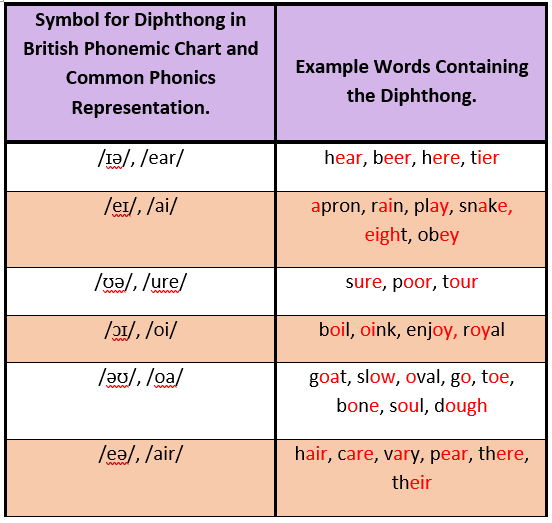Definitions, examples and pronunciation.
Disclaimer: We support the upkeep of this site with advertisements and affiliate links. We may earn a small commission if you click on the ads or links or make a purchase. There is no additional cost to you if you choose to do this.
Diphthongs
A diphthong is a type of vowel sound that’s formed from a combination of two separate vowel sounds merging together in the same syllable. They are sometimes called ‘gliding’ vowels.
The word is derived from Greek and it literally means “two sounds”. An example of a diphthong is the sound represented by the digraph ‘oi’ in ‘boil’, or ‘oy’ in ‘boy’. The sound represented by ‘ow’ in clown or by ‘ou’ in shout is also a diphthong, as is the sound represented by the digraph ‘ai’ in the word snail or ‘ay’ in the word ‘play’.
The term ‘diphthong’ is most commonly used by linguists. It’s rarely used in phonics instruction in schools in the UK and most teachers there are unfamiliar with the expression. However, they do teach the diphthong sounds and the different ways of spelling them.
How Many Diphthongs Are There in English?
Most sources say that British English has 8 diphthongs; these are shown in the table below:

However, people with different accents pronounce some words differently, so there might be small variations in the number of diphthongs spoken in different English-speaking regions.
Pronunciation of Diphthongs
The first video below describes how to pronounce diphthongs in British English and the one beneath it provides the American English pronunciation.
What’s the Difference Between a Diphthong and a Digraph?
Diphthongs are a particular group of sounds (or phonemes) in spoken words and digraphs are a combination of 2 letters that spell (or represent) the sounds in writing.
We’ve listed the 8 diphthongs in British English and the different spellings for them in the table above.
Note that some diphthongs are represented by 3 letters (trigraphs). For example, ‘igh’ in light or ‘eer’ in beer. And some diphthongs can be represented by 4 letters, such as ‘eigh’ in eight.
Not all digraphs represent diphthongs. For example, the digraph ‘ch’ in cheese spells a consonant sound as does the digraph ‘sh’ in ship and ‘ph’ in phonics.
Murmur Diphthongs
This unusual phrase is sometimes used to describe vowels that are followed by the letter ‘r’ They are also known as r-controlled vowels.
There are 5 murmur diphthongs:
- ‘ar’, as in arm, car, dark and farm,
- ‘or’ as in born, cork, for and horse,
- ‘er’ as in fern, germ, her and person,
- ‘ir’ as in bird, chirp, dirt and girl,
- ‘ur’ as in burn, fur, hurt and nurse.
Note that ‘er’, ‘ir’ and ‘ur’ all represent the same sound.
The term ‘murmur diphthong’ is rarely used in phonics instruction in schools in the UK, but it is used in some US reading programmes.